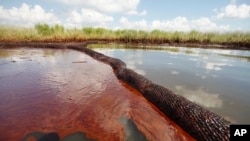New research finds that a tiny microbe may play a big role in cleaning up oil spills and natural gas leaks.
The 2010 Deepwater Horizon oil rig accident in the Gulf of Mexico was the largest marine disaster in U.S. history, killing 11 people and spewing nearly five million barrels of oil into the water. According to the U.S. Environmental Protection Agency, some 14,000 spills are reported each year in the United States where oil and gas flow through a network of pipelines and are carried by barge, rail, and truck.
Microbe feeds on natural gas
Scientists have identified some 100 microbes that feed on methane, a byproduct of natural gas. Methane is also a potent climate-changing gas that warms the atmosphere. Writing in the journal Nature, environmental microbiologist Colin Murrell and colleagues at the University of East Anglia in England take a closer look at the genetic makeup of a single bacteria strain called Methylocella silvestris.
The microbe is found in peat, tundra and forest soils in northern Europe. It was also detected in the Deepwater Horizon spill. Murrell says lab-based experiments found that it has a healthy appetite for components in natural gas.
“We tested for growth on propane and sure enough it grows very happily on propane as well as methane,” Murrell said. “This is the uniqueness of the work that we’ve got one organism that seems to be able to acquire the ability to grow on these different gases together.”
Study looks for what triggers appetite
But growth in a controlled laboratory experiment is far different from what happens in the natural environment, which is why researchers want to understand how the microbes work and what enzymes and what genes are being used by that bacterium to grow on either methane or propone.
"Then we can start to build up a picture of whether they are going to be useful in a sort of commercial context in terms of cleanup of oil spills or cleanup of a whole variety of different compounds,” Murrell said.
Murrell wants to identify other microbes in the environment that work in similar ways and says high-tech tools are available to do the job.
“We have specific gene and molecular probes that we can now use to go back and interrogate environmental samples to see if these organisms are present there in the first place,” he said.
Science helps decision-makers clean air
Murrell said the findings can help inform decision-makers on the potential advantage microbes offer for remediation. “In terms of cleanup of the environment or in context of different organisms making useful chemicals in a biologically clean way rather than using a lot of hazardous chemicals.”
Molecule for molecule, Murrell says, the effect of methane on global warming is more than 20 times greater than carbon dioxide over a span of 100 years. He added, 'It is important, to understand how it can be removed naturally in the environment before it is released into the atmosphere.
The 2010 Deepwater Horizon oil rig accident in the Gulf of Mexico was the largest marine disaster in U.S. history, killing 11 people and spewing nearly five million barrels of oil into the water. According to the U.S. Environmental Protection Agency, some 14,000 spills are reported each year in the United States where oil and gas flow through a network of pipelines and are carried by barge, rail, and truck.
Microbe feeds on natural gas
Scientists have identified some 100 microbes that feed on methane, a byproduct of natural gas. Methane is also a potent climate-changing gas that warms the atmosphere. Writing in the journal Nature, environmental microbiologist Colin Murrell and colleagues at the University of East Anglia in England take a closer look at the genetic makeup of a single bacteria strain called Methylocella silvestris.
The microbe is found in peat, tundra and forest soils in northern Europe. It was also detected in the Deepwater Horizon spill. Murrell says lab-based experiments found that it has a healthy appetite for components in natural gas.
“We tested for growth on propane and sure enough it grows very happily on propane as well as methane,” Murrell said. “This is the uniqueness of the work that we’ve got one organism that seems to be able to acquire the ability to grow on these different gases together.”
Study looks for what triggers appetite
But growth in a controlled laboratory experiment is far different from what happens in the natural environment, which is why researchers want to understand how the microbes work and what enzymes and what genes are being used by that bacterium to grow on either methane or propone.
"Then we can start to build up a picture of whether they are going to be useful in a sort of commercial context in terms of cleanup of oil spills or cleanup of a whole variety of different compounds,” Murrell said.
Murrell wants to identify other microbes in the environment that work in similar ways and says high-tech tools are available to do the job.
“We have specific gene and molecular probes that we can now use to go back and interrogate environmental samples to see if these organisms are present there in the first place,” he said.
Science helps decision-makers clean air
Murrell said the findings can help inform decision-makers on the potential advantage microbes offer for remediation. “In terms of cleanup of the environment or in context of different organisms making useful chemicals in a biologically clean way rather than using a lot of hazardous chemicals.”
Molecule for molecule, Murrell says, the effect of methane on global warming is more than 20 times greater than carbon dioxide over a span of 100 years. He added, 'It is important, to understand how it can be removed naturally in the environment before it is released into the atmosphere.







